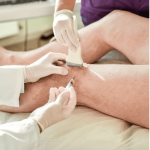Introduction:
As individuals age, joint health often becomes a paramount concern due to wear and tear, leading to conditions like osteoarthritis and tendon disorders. In the realm of joint treatments, knee gel injections, particularly those containing Hyaluronic Acid (HA), have gained popularity. This comprehensive guide aims to delve into the intricacies of knee gel injections, focusing on their benefits, especially those associated with HA, and examining potential risks that individuals should be aware of before opting for this treatment.
Understanding Hyaluronic Acid Joint Injections:
Hyaluronic Acid (HA) joint injections have become a common method for managing joint and tendon disorders. Unlike steroid injections that aim to rapidly reduce inflammation, HA injections focus on improving joint function by providing lubrication and cushioning to the affected area. The procedure involves injecting a gel-like substance directly into the knee joint, mimicking the naturally occurring HA found in synovial fluid.
Benefits of HA Joint Injections:
1. Reduced Inflammation and Improved Joint Function:
- HA injections are renowned for their ability to reduce inflammation within the joint, offering relief from pain and discomfort.
- The lubricating properties of HA contribute to smoother joint movement, enhancing overall functionality.
2. Gradual and Sustained Relief:
- Unlike the rapid but temporary relief provided by steroid injections, HA injections offer a more gradual but longer-lasting solution.
- Patients may experience sustained improvement in symptoms over an extended period, potentially delaying the need for more invasive interventions like surgery.
3. Minimal Side Effects:
- HA injections typically have low risks and side effects compared to some other interventions.
- The gel closely resembles the body’s natural HA, minimizing the likelihood of adverse reactions.
Potential Risks Associated with HA Joint Injections:
1. Nerve Injury and Worsening of Symptoms:
- While the risk is minimal (less than 0.1%), short-term nerve injury can lead to a sustained increase in symptoms. Monitoring for any unusual sensations or pain is crucial.
2. Infection:
- As with any medical intervention, there is a slight risk of infection (0.005% – 0.0002%). Symptoms of septic arthritis, such as fever and increasing joint pain, should prompt immediate medical attention.
3. Joint Swelling:
- Temporary joint swelling may occur but is usually short-lived and poses minimal concern.
4. Treatment Failure:
- Although rare, there is a possibility that the injections may not produce the desired results. Patient expectations should be managed accordingly.
5. Risk of Bleeding:
- Individuals on blood-thinning medications should exercise caution, as there is a risk of bleeding, especially at the injection site. Close collaboration with healthcare providers is essential.
6. Other Potential Complications:
- Rare complications may include feeling flush or faint, allergic reactions, menstrual irregularities, vascular damage, and a small risk of temporary immunosuppression. These occurrences, though infrequent, warrant consideration.
Conclusion:
Knee gel injections, particularly those containing Hyaluronic Acid, present a promising avenue for individuals seeking relief from joint and tendon disorders. While the benefits are substantial, understanding and acknowledging the potential risks are equally crucial. As with any medical procedure, individuals considering HA joint injections should engage in open communication with their healthcare providers to make informed decisions about their treatment journey. Always remember that individual responses to treatments can vary, and a personalized approach is key to achieving the best possible outcomes.













